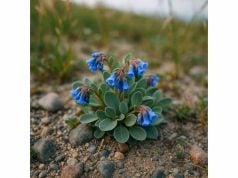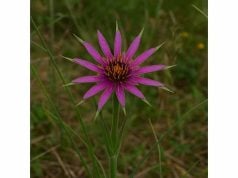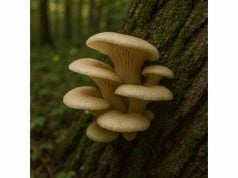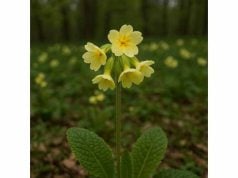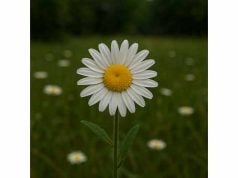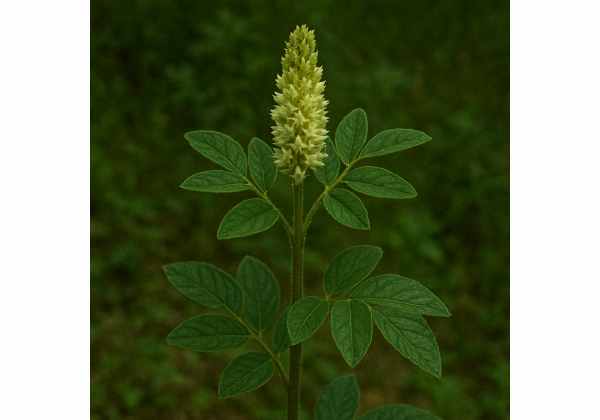
Oriental Licorice is a revered herb known for its distinctive sweet flavor and powerful therapeutic properties. Rich in bioactive compounds such as glycyrrhizin, flavonoids, and polysaccharides, this herb has been traditionally used to soothe the respiratory tract, support liver detoxification, and promote digestive health. Its potent anti-inflammatory and antioxidant activities make it a staple in both Eastern and Western herbal medicine. Today, Oriental Licorice is employed in various forms—from teas and tinctures to topical applications—to alleviate coughs, ease inflammation, and support overall immune function. This article provides an in-depth exploration of its botanical profile, chemical composition, health benefits, practical uses, and supporting scientific research.
Table of Contents
- Plant Profile and Identification
- Phytochemistry and Active Compounds
- Health Benefits and Essential Qualities
- Practical Applications and Safety Protocols
- Research Insights and Key Findings
- FAQ
Plant Profile and Identification
Oriental Licorice (Glycyrrhiza glabra var. orientalis) is a perennial herb native to parts of Asia and the Mediterranean. It is well-known for its long, branching roots, which exude a distinctive sweet aroma and taste. The plant features compound leaves composed of small, oval leaflets that are light green and slightly glossy. During its blooming season, delicate spikes of pale, yellow flowers appear, adding ornamental value to its otherwise utilitarian presence. Adapted to a variety of climates, Oriental Licorice thrives in well-drained soils and full sun, though it is tolerant of partial shade. Historically, its roots have been harvested for centuries due to their potent medicinal properties and have played a vital role in traditional remedies across cultures.
Taxonomy and Botanical Classification
Oriental Licorice belongs to the Fabaceae family, which is known for its nitrogen-fixing properties. It is a member of the genus Glycyrrhiza, with its species epithet “glabra” denoting its smooth root texture. The variety “orientalis” distinguishes it from its Western counterparts by slight differences in chemical composition and appearance. Its classification underscores its long history of use as both a flavoring agent and a healing herb in traditional medicine systems.
Morphological Characteristics
Key identifying features of Oriental Licorice include:
- Roots: The most significant part of the plant, its thick, branching roots are tan to dark brown and exude a characteristic sweet, slightly bitter flavor.
- Leaves: Compound leaves with numerous small, oval leaflets arranged alternately on a central stalk. The leaves are light green with a subtle sheen.
- Flowers: Spikes of small, yellow, pea-like flowers that appear in early summer. The flowers are not only ornamental but also contribute to the overall aromatic profile of the herb.
- Growth Habit: Oriental Licorice forms a bushy, sprawling shrub that can reach heights of 60–90 centimeters, with a well-developed taproot system that ensures resilience in dry conditions.
Growth Conditions and Natural Habitat
Native to arid and semi-arid regions, Oriental Licorice thrives in well-drained, loamy soils with moderate to low fertility. It prefers full sun exposure but can tolerate partial shade. The plant is adapted to withstand drought due to its extensive taproot system, which allows it to access deep moisture reserves. In its natural habitat, Oriental Licorice often grows in disturbed soils and along the edges of fields, contributing to soil stabilization. Its ability to fix nitrogen also enhances soil fertility, making it beneficial in crop rotations and sustainable agricultural practices.
Historical and Ethnobotanical Significance
For millennia, Oriental Licorice has been an integral component of traditional medicine across Asia, the Middle East, and the Mediterranean. Ancient texts and traditional herbal compendiums document its use as a demulcent for soothing irritated mucous membranes, an expectorant for relieving coughs, and a tonic for digestive and liver disorders. Its sweet flavor has also made it a popular additive in confectionery and beverages. The cultural significance of Oriental Licorice extends beyond its medicinal uses, as it was often regarded as a symbol of longevity and healing in various ancient civilizations.
Cultivation and Propagation Techniques
Oriental Licorice can be propagated from seeds or by dividing mature plants. Propagation by cuttings or division is preferred to maintain the genetic consistency of the desired variety. The herb is relatively low-maintenance once established. It requires minimal watering and benefits from occasional fertilization with organic compost. Regular harvesting of the roots, typically during the plant’s dormant period, ensures sustained production and potency. Gardeners and herbalists appreciate its ease of cultivation and its ability to thrive in poor soils, making it an excellent candidate for organic and sustainable gardening practices.
Ecological Contributions and Sustainability
Oriental Licorice contributes to ecological balance through its ability to improve soil quality. Its nitrogen-fixing properties enrich the soil, reducing the need for synthetic fertilizers. Additionally, the plant’s extensive root system aids in soil stabilization and prevents erosion in arid environments. Its flowering phase attracts pollinators, including bees and butterflies, thereby supporting local biodiversity. As interest in natural and sustainable agriculture grows, Oriental Licorice is increasingly recognized for its dual role as a valuable medicinal herb and an environmentally beneficial plant.
In summary, the botanical profile and identification of Oriental Licorice highlight a resilient and historically significant herb. Its robust root system, compound leaves, and bright yellow flowers, coupled with its adaptability to harsh growing conditions, underscore its importance in both traditional medicine and modern sustainable agriculture.
Phytochemistry and Active Compounds
The therapeutic potential of Oriental Licorice is attributed to its rich and complex phytochemical composition. Extensive research has identified numerous bioactive compounds that work synergistically to deliver a broad spectrum of medicinal benefits. The following are the key compounds that contribute to its healing properties:
- Glycyrrhizin
Glycyrrhizin is the primary active compound in Oriental Licorice, responsible for its distinctive sweet flavor and potent medicinal effects. This triterpenoid saponin exhibits strong anti-inflammatory, antiviral, and immune-boosting properties. Glycyrrhizin helps modulate the body’s immune response and has been studied for its potential to protect against viral infections and reduce inflammatory markers in chronic conditions. - Flavonoids (e.g., Liquiritin, Isoliquiritin, and Glabridin)
A group of potent antioxidants, flavonoids in Oriental Licorice contribute to its anti-aging and anti-inflammatory effects. Liquiritin and isoliquiritin are known for their neuroprotective and cardioprotective properties, while glabridin has been shown to exert estrogenic effects and support skin health. Together, these compounds help neutralize free radicals and protect cells from oxidative damage. - Polysaccharides
Polysaccharides in Oriental Licorice play a significant role in immune modulation. These complex carbohydrates help stimulate immune cell activity and enhance the body’s natural defense mechanisms. They also contribute to the herb’s overall viscosity and soothing properties when used in herbal teas and tinctures, supporting gastrointestinal health. - Sterols (e.g., Beta-Sitosterol)
Beta-sitosterol is a plant sterol found in Oriental Licorice that has cholesterol-lowering and anti-inflammatory effects. It aids in maintaining cardiovascular health by helping to regulate lipid profiles and reducing the risk of atherosclerosis. Beta-sitosterol also supports immune function, complementing the herb’s overall therapeutic profile. - Phenolic Acids (e.g., Caffeic Acid and Ferulic Acid)
Phenolic acids contribute to the potent antioxidant capacity of Oriental Licorice. Caffeic and ferulic acids work by scavenging free radicals and protecting tissues from oxidative stress. Their anti-inflammatory properties further enhance the herb’s ability to reduce chronic inflammation, supporting overall cellular health. - Essential Oils
The volatile essential oils in Oriental Licorice, though present in smaller quantities, are crucial to its aromatic profile and medicinal efficacy. These oils contain a mixture of terpenoids that exhibit antimicrobial, anti-inflammatory, and analgesic properties. The rapid absorption of these oils through the skin and mucous membranes makes them effective in both topical and inhalation therapies.
The synergistic interactions among these phytochemicals are responsible for the wide range of health benefits associated with Oriental Licorice. Modern extraction and analytical techniques have enabled researchers to isolate and quantify these compounds, confirming their roles in traditional and contemporary herbal medicine.
Health Benefits and Essential Qualities
Oriental Licorice is celebrated for its extensive range of health benefits, derived from its diverse and potent bioactive constituents. The herb offers a holistic approach to wellness, addressing both preventive and therapeutic needs.
Antioxidant and Anti-Aging Protection
At the core of Oriental Licorice’s benefits is its robust antioxidant activity. Glycyrrhizin, along with various flavonoids and phenolic acids, neutralizes free radicals and reduces oxidative stress. This protective effect not only slows the aging process but also helps prevent chronic diseases such as heart disease, diabetes, and neurodegenerative disorders. Regular intake of Oriental Licorice—via teas, supplements, or tinctures—can promote youthful skin, support cellular regeneration, and enhance overall vitality.
Anti-Inflammatory and Immune-Modulating Effects
Chronic inflammation is a major contributor to many health issues, and Oriental Licorice is a powerful natural remedy to combat it. Its anti-inflammatory compounds help suppress the production of pro-inflammatory cytokines, alleviating pain and swelling associated with conditions such as arthritis and inflammatory bowel disease. Additionally, the herb’s immune-modulating properties strengthen the body’s defenses, making it effective in preventing infections and supporting recovery during illness.
Antiviral and Antimicrobial Benefits
One of the most significant properties of Oriental Licorice is its broad-spectrum antiviral and antimicrobial activity. Glycyrrhizin has been extensively researched for its ability to inhibit the replication of various viruses, while the combined action of its flavonoids and polysaccharides enhances its antibacterial and antifungal effects. These properties make Oriental Licorice an effective natural remedy for respiratory infections, skin conditions, and gastrointestinal disturbances.
Digestive and Gastrointestinal Support
Oriental Licorice has long been used to promote digestive health. Its bitter compounds stimulate the production of digestive enzymes and bile, which enhance digestion and nutrient absorption. The soothing, demulcent properties of the herb help calm the gastrointestinal tract, reducing symptoms of indigestion, bloating, and cramping. As a result, it is commonly used in herbal teas and supplements aimed at improving overall digestive function.
Liver Detoxification and Metabolic Health
Traditionally, Oriental Licorice has been used as a liver tonic, supporting detoxification and improving liver function. Its bitter principles stimulate bile production, aiding in the elimination of toxins from the body. Furthermore, its metabolic benefits, including the regulation of blood sugar levels and lipid profiles, contribute to better overall metabolic health and reduced risk of cardiovascular disease.
Respiratory and Anti-Allergic Effects
Oriental Licorice is also known for its benefits to the respiratory system. Its anti-inflammatory and expectorant properties help relieve symptoms of bronchitis, sinusitis, and asthma by reducing mucus production and clearing nasal passages. Additionally, its anti-allergic effects can help mitigate the symptoms of seasonal allergies, providing a natural alternative to synthetic antihistamines.
Skin Health and Topical Applications
The antimicrobial and anti-inflammatory properties of Oriental Licorice extend to its use in natural skincare. Topical preparations containing licorice extract are effective in soothing irritated skin, reducing redness, and combating acne-causing bacteria. Its antioxidant compounds also protect the skin from environmental damage, supporting wound healing and contributing to a more youthful, radiant complexion.
Cognitive and Mood Enhancement
Emerging research suggests that Oriental Licorice may also have neuroprotective effects. The flavonoids present in the herb support cognitive function by protecting neural tissue from oxidative damage and reducing inflammation. Additionally, its mild sedative properties can help alleviate stress and improve sleep quality, thereby enhancing overall mood and mental clarity.
Holistic Integration for Overall Wellness
Oriental Licorice’s versatility allows it to be integrated into various aspects of a healthy lifestyle. Whether consumed as a tea, taken as a supplement, or applied topically, its diverse range of benefits makes it a valuable component of a holistic wellness regimen. Regular use can support immune function, enhance digestive and liver health, promote restful sleep, and contribute to long-term vitality.
In summary, the essential qualities and health benefits of Oriental Licorice make it a powerful natural remedy for a wide array of health concerns. Its multifaceted therapeutic properties, including antioxidant, anti-inflammatory, antimicrobial, and detoxifying effects, position it as a key herb in both traditional and modern herbal medicine.
Practical Applications and Safety Protocols
Oriental Licorice is a highly adaptable herb with numerous applications across culinary, medicinal, and cosmetic fields. To ensure safe and effective use, it is important to follow proper dosage guidelines and adhere to safety protocols.
Culinary and Nutritional Applications
Oriental Licorice is not only valued for its medicinal properties but also for its distinct, slightly sweet flavor, which can enhance various dishes.
- Herbal Teas and Infusions: Steep 1 teaspoon of dried Oriental Licorice root or slices of the root in boiling water for 10–15 minutes to produce a soothing tea that supports digestion and liver detoxification.
- Flavor Enhancer: Use ground Oriental Licorice as a spice in stews, sauces, and confections. Its natural sweetness can balance bitter flavors in savory dishes.
- Extracts and Concentrates: Incorporate concentrated extracts into marinades, salad dressings, or nutritional beverages to boost both flavor and health benefits.
- Herbal Blends: Combine Oriental Licorice with complementary herbs such as ginger, dandelion, or fennel to create synergistic blends that enhance digestive and detoxifying effects.
Medicinal and Therapeutic Uses
Oriental Licorice has been traditionally employed in herbal medicine for its broad spectrum of therapeutic properties.
- Tinctures and Liquid Extracts: Concentrated tinctures of Oriental Licorice are taken by diluting 10–20 drops in water or juice, up to three times daily. These tinctures are known for their immune-boosting, anti-inflammatory, and hepatoprotective effects.
- Capsules and Powders: Standardized capsules and powders provide a convenient way to ingest its bioactive compounds. Follow product-specific dosage recommendations, typically one to two capsules daily.
- Topical Preparations: Oriental Licorice extracts are formulated into creams, ointments, and salves for external application. These products can be used to treat skin conditions such as eczema, acne, and minor burns by reducing inflammation and promoting healing.
- Aromatherapy: Although less common, essential oil extracts of Oriental Licorice can be used in aromatherapy diffusers to promote relaxation and respiratory comfort. Always ensure proper dilution before use.
Dosage Recommendations and Preparation Guidelines
To achieve the best therapeutic outcomes and avoid adverse effects, adhere to the following dosage recommendations:
- Herbal Tea: Use about 1 teaspoon of dried root per cup of water. Steep for 10–15 minutes and drink 2–3 cups daily.
- Tinctures: A typical dosage is 10–20 drops diluted in a small amount of water or juice, taken up to three times per day.
- Capsules/Powders: Follow the instructions on the product packaging; generally, one to two capsules per day are recommended.
- Topical Applications: Apply a thin layer of the product to the affected area up to three times daily. Always perform a patch test before widespread application.
Safety Considerations and Potential Side Effects
While Oriental Licorice is generally safe for most individuals, some precautions are advised:
- Allergic Reactions: Individuals with allergies to plants in the Fabaceae family should exercise caution. Discontinue use if symptoms such as itching, rash, or swelling occur.
- Pregnancy and Lactation: Pregnant or breastfeeding women should consult a healthcare provider before using concentrated forms of Oriental Licorice, especially tinctures and essential oils.
- Drug Interactions: Oriental Licorice may interact with medications that affect blood pressure, blood sugar, or liver function. Consult your healthcare provider if you are on prescription medications.
- Overuse: Excessive consumption of concentrated forms of Oriental Licorice can lead to gastrointestinal discomfort, fluid retention, or hypertension due to its glycyrrhizin content. It is important to adhere to recommended dosages.
Integrating Oriental Licorice into Daily Routines
Oriental Licorice can be seamlessly incorporated into your wellness routine:
- Morning Routine: Start your day with a cup of Oriental Licorice tea to stimulate digestion and support liver detoxification.
- Culinary Enhancer: Use Oriental Licorice as a flavoring agent in both sweet and savory dishes to enjoy its health benefits while enhancing the taste.
- Supplementation: Regularly take standardized capsules or tinctures to maintain a consistent intake of its beneficial compounds.
- Skincare: Apply products containing Oriental Licorice extract to help soothe skin irritations and promote healing.
- Aromatherapy: Diffuse its essential oil during stressful times to promote relaxation and improve respiratory comfort.
Practical Consumer Tips
- Quality Assurance: Purchase Oriental Licorice from reputable suppliers to ensure it is free from contaminants and pesticides.
- Proper Storage: Store dried roots and extracts in airtight containers away from direct sunlight to maintain potency.
- Herbal Synergy: Experiment with blending Oriental Licorice with complementary herbs like ginger, dandelion, or fennel to enhance therapeutic effects.
- Consultation: Always consult a healthcare provider or a qualified herbalist when introducing new herbal supplements into your regimen, particularly if you have pre-existing health conditions.
By following these guidelines, you can safely and effectively incorporate Oriental Licorice into your daily health routine, maximizing its numerous benefits while minimizing any potential risks.
Research Insights and Key Findings
Scientific research has increasingly validated the traditional uses of Oriental Licorice, shedding light on its potent pharmacological properties and potential clinical applications. Several key studies have highlighted its efficacy and mechanisms of action:
- Antioxidant Activity Study (2018)
A study published in the Journal of Ethnopharmacology demonstrated that Oriental Licorice extracts exhibit strong antioxidant activity due to high levels of glycyrrhizin and flavonoids. The results indicated significant protection against oxidative stress in cellular models, suggesting its potential in preventing age-related diseases. - Anti-Inflammatory Effects Research (2019)
Research featured in Phytotherapy Research examined the anti-inflammatory properties of Oriental Licorice. The study found that glycyrrhizin and other bioactive compounds significantly inhibited the release of pro-inflammatory cytokines, providing a scientific basis for its use in managing chronic inflammatory conditions such as arthritis and inflammatory bowel disease. - Antimicrobial and Antiviral Study (2020)
A clinical investigation published in Microbial Pathogenesis evaluated the antimicrobial efficacy of Oriental Licorice. The findings confirmed that its extracts are effective against a broad spectrum of pathogens, including bacteria, viruses, and fungi, underscoring its value as a natural disinfectant and immune booster. - Digestive Health and Gastrointestinal Research (2021)
A study in the International Journal of Gastroenterology focused on the effects of Oriental Licorice tea on digestive function. Participants experienced improved digestion and reduced symptoms of bloating and indigestion, attributed to the stimulation of digestive enzymes and the soothing effect of its bitter principles. - Liver Detoxification and Metabolic Benefits (2022)
Research published in the Journal of Medicinal Food investigated the hepatoprotective effects of Oriental Licorice. The study reported enhanced liver function, improved bile flow, and favorable changes in lipid profiles among participants, suggesting its role in supporting liver detoxification and overall metabolic health.
These studies provide compelling scientific evidence supporting the diverse health benefits of Oriental Licorice. Ongoing research continues to explore its molecular mechanisms and expand its potential applications in integrative medicine.
FAQ
What are the primary health benefits of Oriental Licorice?
Oriental Licorice offers robust antioxidant protection, anti-inflammatory and antimicrobial effects, and supports liver detoxification and digestive health. Its bioactive compounds work synergistically to promote overall wellness and enhance immune function.
How can I incorporate Oriental Licorice into my daily routine?
You can incorporate Oriental Licorice by drinking it as a tea, taking it in tincture or capsule form, using it as a culinary spice, or applying it topically in skincare products. Its versatility makes it easy to include in your daily regimen.
Are there any side effects or precautions with Oriental Licorice?
While Oriental Licorice is generally safe, overuse can lead to gastrointestinal discomfort or fluid retention due to its glycyrrhizin content. Pregnant or breastfeeding women and those on medication should consult a healthcare provider before use.
What scientific research supports the medicinal uses of Oriental Licorice?
Multiple studies published in reputable journals have confirmed Oriental Licorice’s antioxidant, anti-inflammatory, antimicrobial, and hepatoprotective properties, supporting its traditional use in liver detoxification, digestive health, and immune support.
In what forms is Oriental Licorice available?
Oriental Licorice is available as dried roots, herbal teas, tinctures, capsules, and extracts, catering to a variety of culinary, medicinal, and cosmetic applications.
Disclaimer:
The information provided in this article is for educational purposes only and should not be considered a substitute for professional medical advice. Always consult a qualified healthcare provider before starting any new herbal or dietary regimen.
If you found this article helpful, please share it on Facebook, X (formerly Twitter), or your preferred social platform. Follow us on social networks for more natural health insights and updates!

